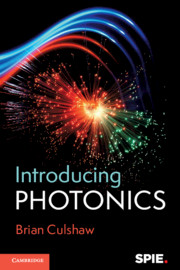6 - The Future
Published online by Cambridge University Press: 21 July 2020
Summary
Chapter 6: looks into emerging and future technologies and how these techniques for manipulating light may become increasingly important.Super-resolution imaging is already becoming a tool for advanced assessments in, for example, clinical diagnostics.Seeing structure with resolution below the optical wavelength enables new insights.Much is made of ‘entanglement’ and unbreakable quantum codes and the optical frequency integrated circuit is becoming a ‘soon to have’ facility.There’s also much emerging in new materials – graphene (single layer carbon) makes scientific headlines and has intriguing optical properties.Society is also becoming more demanding of technology and many important social and environmental challenges have been identified – there is much potential for photonics as the tool to address these needs.The future looks very optimistic!
Keywords
- Type
- Chapter
- Information
- Introducing Photonics , pp. 109 - 128Publisher: Cambridge University PressPrint publication year: 2020



